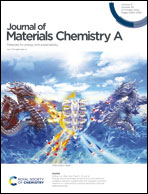Highly stretchable and flexible supercapacitors based on electrospun PEDOT:SSEBS electrodes†
Abstract
Stretchable and flexible supercapacitors with high energy and power densities are in demand for applications in wearable electronics. Here we report a highly stretchable and flexible supercapacitor based on electrospun PEDOT:SSEBS microfiber mats as the supercapacitor electrodes and a freeze-thawed PVA-H2SO4 hydrogel as the solid-state electrolyte. The electrodes are prepared by electrospinning of porous SSEBS microfiber mats and oxidative polymerisation of PEDOT on the mats, from a range of PEDOT solution concentrations. A full electrochemical analysis of the electrodes, including conductivity measurements, cyclic voltammometry, galvanostatic charge–discharge and the electrochemical impedance spectroscopy, is performed, as well as stress–strain mechanical analysis. The maximum areal capacitance of the electrodes, optimised in terms of PEDOT content, is 1296 mF cm−2. The stretchable supercapacitor devices retain 89.5% of the initial capacitance after being stretched to 500% with the electrodes made of 0.5 M PEDOT:SSEBS. The electrode prepared with 1.0 M PEDOT:SSEBS has a maximum areal capacitance of 996 mF cm−2 and retains 100% of its initial capacitance after bending to 180°. These outstanding performances can be attributed to the highly porous and interconnected voids in the electrospun fibers and their stable mechanical properties upon stretching and bending cycles.



 Please wait while we load your content...
Please wait while we load your content...